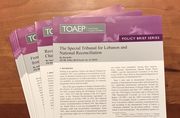Table of contents:
3.1. The perpetrator confined one or more women.
3.1.1. Evidence showing confinement of one or more women.
3.2. The women had been forcibly made pregnant.
3.2.2. Evidence that one or more women were forcibly made pregnant.
3.3. The perpetrator intended to affect the ethnic composition of any population; or.
3.4. The perpetrator intended to carry out grave violations of international law.
Element:
3.1. The perpetrator confined one or more women.
As noted by ICC Pre-Trial Chamber in The Prosecutor v. Dominic Ongwen:
"96. Under charges 58 and 59, the Prosecutor charges Dominic Ongwen with the crime of forced pregnancy as a crime against humanity under article 7(1)(g) and as a war crime under article 8(2)(e)(vi) of the Statute.
97. Article 7(2)(f) of the Statute defines the crime of forced pregnancy as "the unlawful confinement of a woman forcibly made pregnant, with the intent of affecting the ethnic composition of any population or carrying out other grave violations of international law". Article 8(2)(e)(vi) of the Statute refers to the same provision for the definition of forced pregnancy as a war crime.
98. At the confirmation hearing, the Defence argued that the Prosecutor has not proven to the requisite threshold the specific intent required for this crime (Transcript T-23, pp. 17-18). It appears that the Defence submits, essentially, that the special intent applies to the act of forcibly making the woman pregnant rather than to the act of confinement of a woman forcibly made pregnant as instead argued by the Prosecutor (Transcript T-21, p. 49).
99. It is clear from the statutory provision that the relevant conduct of the crime of forced pregnancy is the "unlawful confinement of a woman forcibly made pregnant". It is therefore the act of confinement which must be carried out with the required special intent. Indeed, the crime of forced pregnancy does not depend on the perpetrators involvement in the womans conception; it is only required that the perpetrator knows that the woman is pregnant and that she has been made pregnant forcibly. It is apparent that the essence of the crime of forced pregnancy is in unlawfully placing the victim in a position in which she cannot choose whether to continue the pregnancy.
100. By the same token, it is not necessary to prove that the perpetrator has a special intent with respect to the outcome of the pregnancy, or that the pregnancy of the woman is in any way causally linked to her confinement. While the first alternative of the special intent requirement (intent of "affecting the ethnic composition of any population") would typically include such component, the second alternative (intent of "carrying out other grave violations of international law") does not call for any such restrictive interpretation.
101. Therefore, the Chamber concludes that the Prosecutors submissions that Dominic Ongwen confined women who had been forcibly made pregnant, with the intent to carry out grave violations of international law, including to use them as his forced wives and to rape, sexually enslave, enslave and torture them, are adequate under the applicable law, and that therefore, contrary to the argument of the Defence, and to the extent as sufficiently established by the evidence, the charges of forced pregnancy can be confirmed." [1]
3.1.1. Evidence showing confinement of one or more women.
3.2. The women had been forcibly made pregnant.
3.2.2. Evidence that one or more women were forcibly made pregnant.
3.3. The perpetrator intended to affect the ethnic composition of any population; or.
3.4. The perpetrator intended to carry out grave violations of international law.







